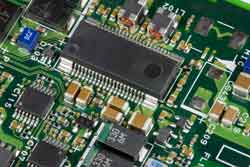Logic / Digital Circuit Design Guidelines
- essential hints, tips and guidelines for designing digital logic circuits that operate correctly.
Logic / Digital Design Guidelines Includes:
Design guidelines overview
Supply decoupling
PCB groundplane usage
Unused gates
Digital logic circuits are widely used in today's' electronics. These circuits are used for a very wide variety of applications.
From simple logic circuits consisting of a few logic gates, through to complicated microprocessor based systems.
Whatever the form of digital logic circuit, there are a number of guidelines and precautions that should be observed when designing, and also when undertaking the circuit board layout.
If the circuit is correctly designed and constructed then problems in the performance can be avoided.

Decoupling
A major point within any set of logic / digital design guidelines and tips for successful digital design is to ensure that the supply line decoupling is properly implemented.
As it is seldom efficient to employ different regulators for different parts of the circuit, noise and other signals can be transferred around the circuit, and could give rise to spurious triggering.
The incorporation of the correct logic decoupling will ensure that the circuit operates correctly and is not subject to issues arising from unwanted signals on the supply line.
Read more about logic supply line decoupling.
Earthing / grounding
Another key element within any set of logic or digital design guidelines is associated with the grounding methods used.
It is necessary to ensure that an effective grounding system is employed on the printed circuit board. There are a number of requirements: ensuring that ground loops are not present; earth return resistances are as low as possible; mutual pick-up is reduced and the like.
By planning the use and format of the ground system from the earliest stages of the design, problems can be minimised and the chance of an expensive and time consuming re-design reduced.
Read more about using PCB ground planes.
Unused inputs
In many circuits there will be some logic gates that remain unused in the circuit. There is a temptation to leave these completely alone. However it is good practice to terminate these circuits so that they do not cause problems and issues.
Read more about using terminating unused gates.
General layout
The layout of a digital logic board can have a significant effect on its performance. With edges of waveforms being very fast, the frequencies that are contained within the waveforms are particularly high. Accordingly leads must be kept as short as reasonably possible if the circuit is to be able to perform correctly. Indeed many high end printed circuit board layout packages contain software that simulates the effects of the leads in the layout. These software packages can be particularly helpful when board or system complexity dictates that lead lengths greater than those that would normally be needed are required to enable the overall system to be realised. However for many instances this level of simulation is not required, and lead lengths can be kept short.
At first sight digital logic circuits may not appear to need all the care and attention given to a radio frequency (RF) circuit, but the speed of some of the edges on the waveform transitions means that very high frequencies are contained within them. To ensure that the optimum performance is obtained, good layout is essential. Obeying a few simple rules can often ensure that the circuit operates correctly
 Written by Ian Poole .
Written by Ian Poole .
Experienced electronics engineer and author.
More Digital Logic and Embedded Topics:
FPGA programming
Embedded systems
How a computer works
Logic circuit design basics
Logic / circuit design guidelines
Return to Digital / Logic / Processing menu . . .


